Jubilee 2025
Short History of Sacred Sites in Belize

St. Peter Claver Church, Punta Gorda, Toledo
More than 150 years ago, Belgian Jesuit Fr. Jean Genon had to choose between Spanish-controlled Guatemala and an English-controlled colony in what is now southern Belize. He decided there was greater love in this unnamed settlement of Garinagu and more need of a church, and that is how St. Peter Claver Parish got its start. {Saint Peter Claver was a Spanish Jesuit priest and missionary born in Verdu Spain. During his forty years of ministry, it is estimated that he baptized around 300,000 people and heard confessions from around 5,000 people.}
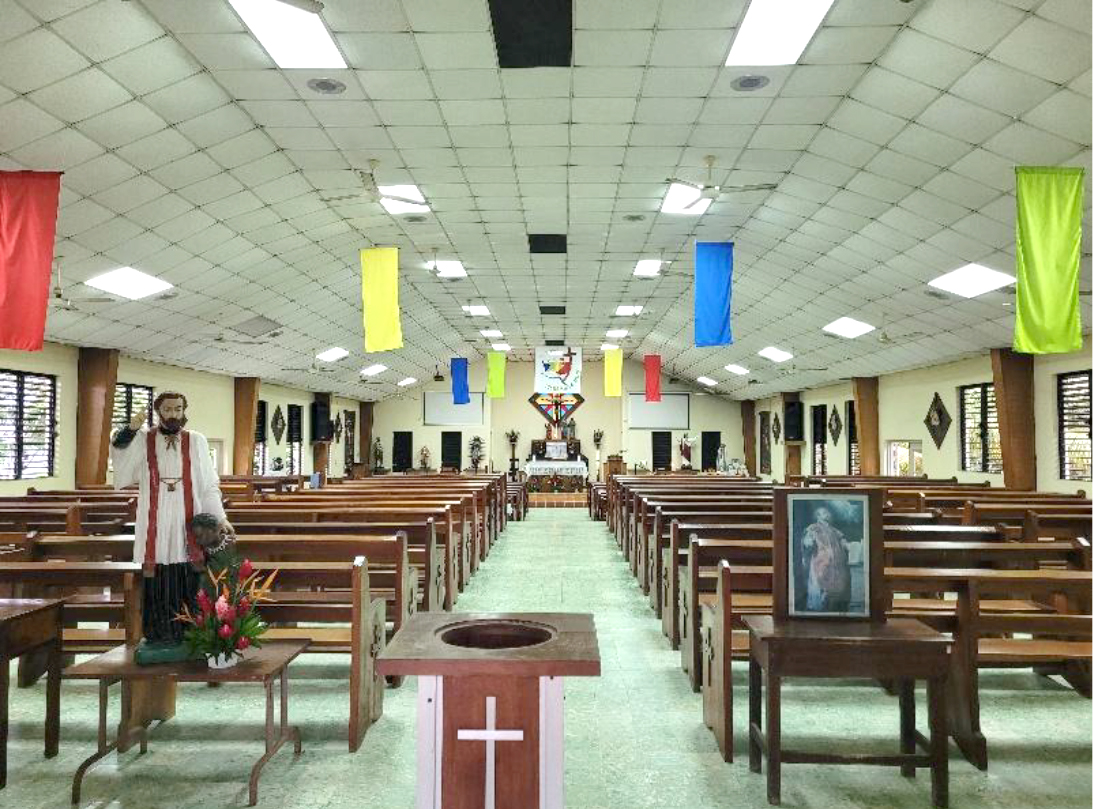 Since the time of Fr. Genon, the Mayas of Guatemala migrated into southern Belize, so the Parish had to extend its coastal outreach into the Maya Mountains. St. Peter Claver RC Church now serves 32 village churches and 29 primary schools spread throughout our Toledo District.
Since the time of Fr. Genon, the Mayas of Guatemala migrated into southern Belize, so the Parish had to extend its coastal outreach into the Maya Mountains. St. Peter Claver RC Church now serves 32 village churches and 29 primary schools spread throughout our Toledo District.
In earlier days, the Jesuits and other priests assigned to St. Peter Claver Parish would walk from village to village, taking about a month to make the circuit. Once the priest arrived in a village, he would celebrate Mass and other sacraments and teach the faith. When it was time to move on to another village, a group would accompany him halfway to the next village, who had their own group waiting to show him the way.
Roads to the villages have arrived over the last few decades, meaning the villages can be reached in a vehicle, often on very rough roads. Some of the farthest villages still take up to three hours to reach by truck.
San Luis Rey (San Antonio - Toledo)
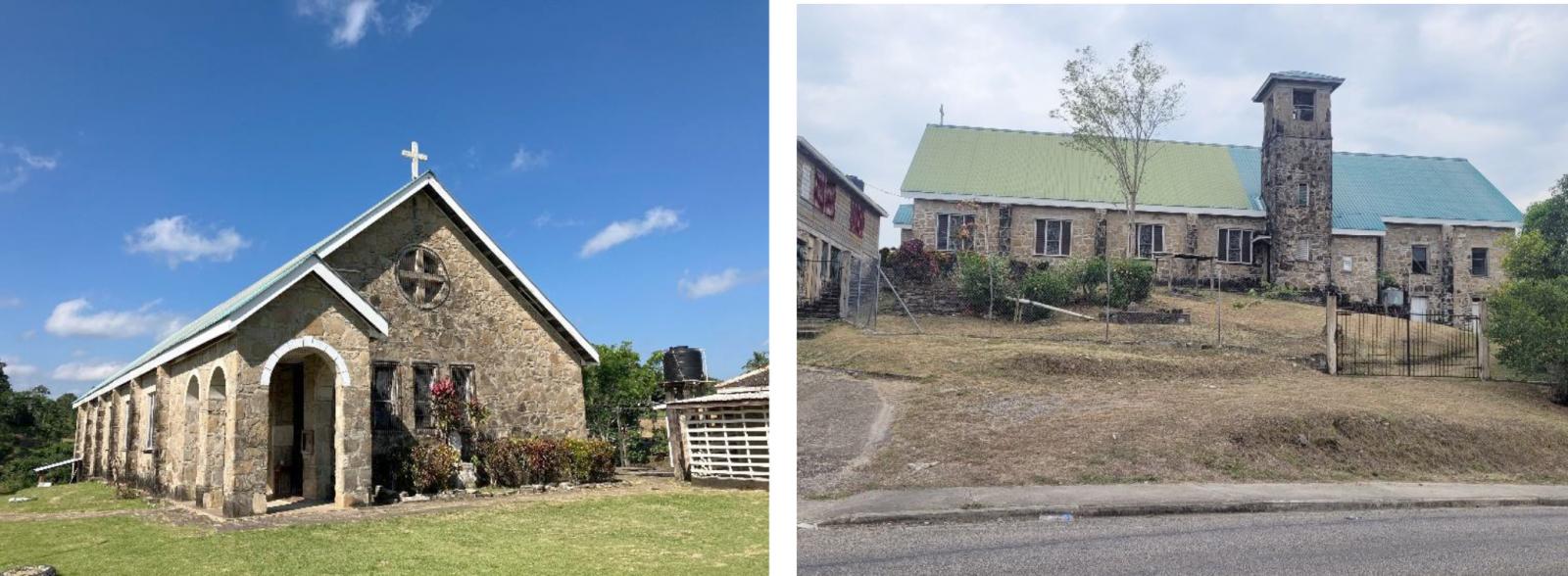 The San Luis Rey Roman Catholic Church, built in 1950, stands as a remarkable symbol of both faith and education in San Antonio, Belize. Its picturesque architecture and serene environment create an inviting atmosphere for all who visit. This church serves as a hub for the community, where spiritual gatherings intertwine with educational activities, making it an integral part of local life. The stunning surroundings provide a peaceful backdrop, perfect for contemplation and reflection. It's a stone Catholic Church, built from limestone salvaged from surrounding Maya ruins. The church is dedicated to San Luis Rey and Mayas from surrounding villages often travel there to worship their patron saint.
The San Luis Rey Roman Catholic Church, built in 1950, stands as a remarkable symbol of both faith and education in San Antonio, Belize. Its picturesque architecture and serene environment create an inviting atmosphere for all who visit. This church serves as a hub for the community, where spiritual gatherings intertwine with educational activities, making it an integral part of local life. The stunning surroundings provide a peaceful backdrop, perfect for contemplation and reflection. It's a stone Catholic Church, built from limestone salvaged from surrounding Maya ruins. The church is dedicated to San Luis Rey and Mayas from surrounding villages often travel there to worship their patron saint. The church also features stained glass windows donated from a church in St. Louis, Missouri, USA.
Nazareth (Cattle Landing - Toledo)
 The Pallottine sisters first settled in Nazareth in 1931 on lands acquired from previous Confederate settlers in the area. Before the building was demolished in the early 1990s after a new convent building was constructed, it also served as a retreat center for various church-based groups.
The Pallottine sisters first settled in Nazareth in 1931 on lands acquired from previous Confederate settlers in the area. Before the building was demolished in the early 1990s after a new convent building was constructed, it also served as a retreat center for various church-based groups.Former members of SEARCH and Parish Lay Ministers from Toledo can recall their retreats there.
The church is Our Lady of Fatima Church, named after Our Lady who appeared in Fatima to Lucia, Francisco and Jacinta on May 13th 1917 and on every thirteenth of the following six months. Her message was that we should pray the Rosary and do penance for our sins.
Our Lady of Mount Carmel (Benque Viejo – Cayo)
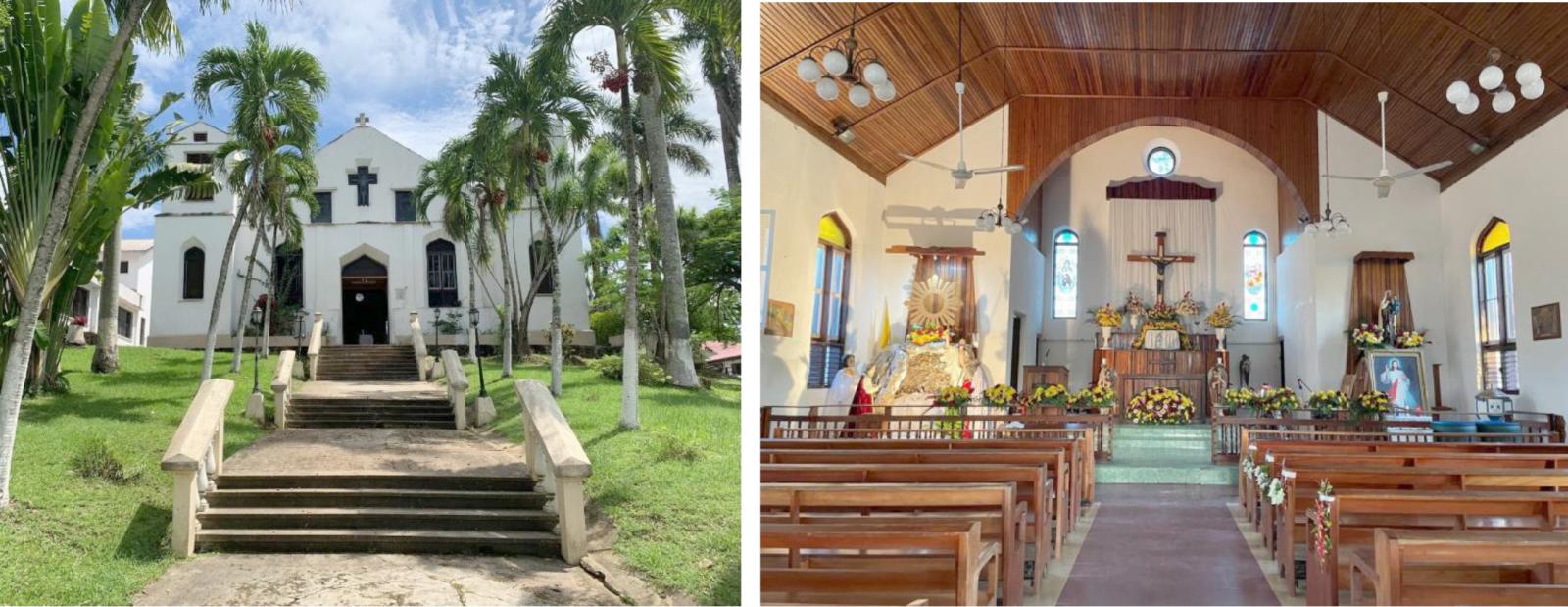 The parish was founded in 1905, with its first pastor being Fr. Buck Stanton, S.J. The longest known serving pastor is Fr. John Mchugh, SOLT, 1969-1999, making it SOLT guided since 1969. The two associate schools were founded and staffed by Pallottine Sisters - Mount Carmel Primary School and St. Joseph Primary School in Succotz. It is the home of beautiful Marimba Masses, the famous Holy Week procession and dramatized Passion on Good Friday. Also, home of the Mount Carmel High School Crusaders and John Paul the Great College.
The parish was founded in 1905, with its first pastor being Fr. Buck Stanton, S.J. The longest known serving pastor is Fr. John Mchugh, SOLT, 1969-1999, making it SOLT guided since 1969. The two associate schools were founded and staffed by Pallottine Sisters - Mount Carmel Primary School and St. Joseph Primary School in Succotz. It is the home of beautiful Marimba Masses, the famous Holy Week procession and dramatized Passion on Good Friday. Also, home of the Mount Carmel High School Crusaders and John Paul the Great College.Our Lady of Guadalupe Co-Cathedral (Belmopan – Cayo)
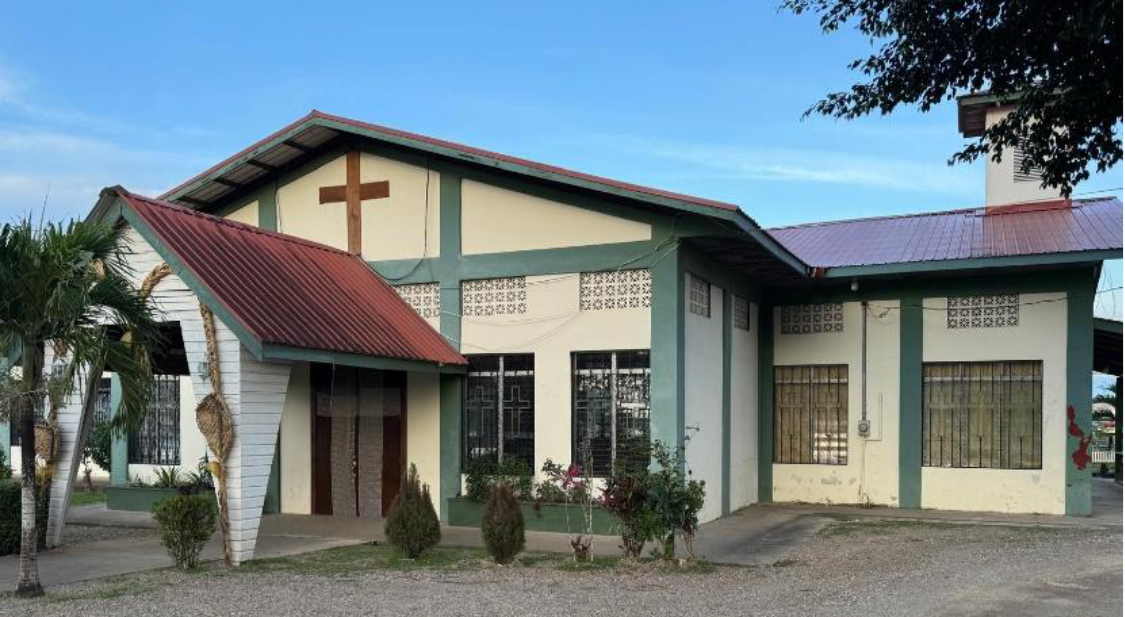 Our Lady of Guadalupe Co-Cathedral is a significant religious site in Belmopan, Belize. It serves as a Co-Cathedral for the Roman Catholic Diocese of Belize City-Belmopan, highlighting its importance in the local Catholic community. The cathedral is known for its architectural design and serves as a central place of worship and community gathering. It plays a vital role in the spiritual life of the region, hosting various religious ceremonies and events throughout the year. The Co-Cathedral is a key landmark in Belmopan, attracting both locals and visitors interested in its religious and cultural significance.
Our Lady of Guadalupe Co-Cathedral is a significant religious site in Belmopan, Belize. It serves as a Co-Cathedral for the Roman Catholic Diocese of Belize City-Belmopan, highlighting its importance in the local Catholic community. The cathedral is known for its architectural design and serves as a central place of worship and community gathering. It plays a vital role in the spiritual life of the region, hosting various religious ceremonies and events throughout the year. The Co-Cathedral is a key landmark in Belmopan, attracting both locals and visitors interested in its religious and cultural significance.San Pablo Catholic Chapel in San Pedro, Ambergris Caye
Catholics living south of San Pedro will be pleased to know that they have a refurbished church in the San Pablo Sub-division. The church building was last cared for in 2015 when it got a good cleaning and a new coat of paint inside the room of worship. On January 25 of that year a ‘revival’ service was led by Father Scott Giuliani, S.O.L.T. who likened the renewal of the church to spiritual healing. It is now freshly painted, showing no signs of wear, with a new tiled floor, altar, a choir room and additional space to accommodate a larger congregation. If you ever visit San Pedro Ambergris Caye, you must visit San Pablo Chapel.
 The initial renovation of the church building began in September 2016. The renovation was successfully completed with the assistance of Graniel’s Construction Company and Cabinet Shop.
The initial renovation of the church building began in September 2016. The renovation was successfully completed with the assistance of Graniel’s Construction Company and Cabinet Shop.The San Pedro Roman Catholic Church is grateful to the community that has breathed life into the San Pablo Church. The newly renovated church was blessed by Bishop Lawrence Nicasio. All faithful Catholics in San Pedro are invited to visit the church. The building will be open every day, from 6:00 a.m. to 6:00 p.m. It is the hope that with these improvements, the church will become very active in this sub-division.
Holy Redeemer Cathedral (Belize City)
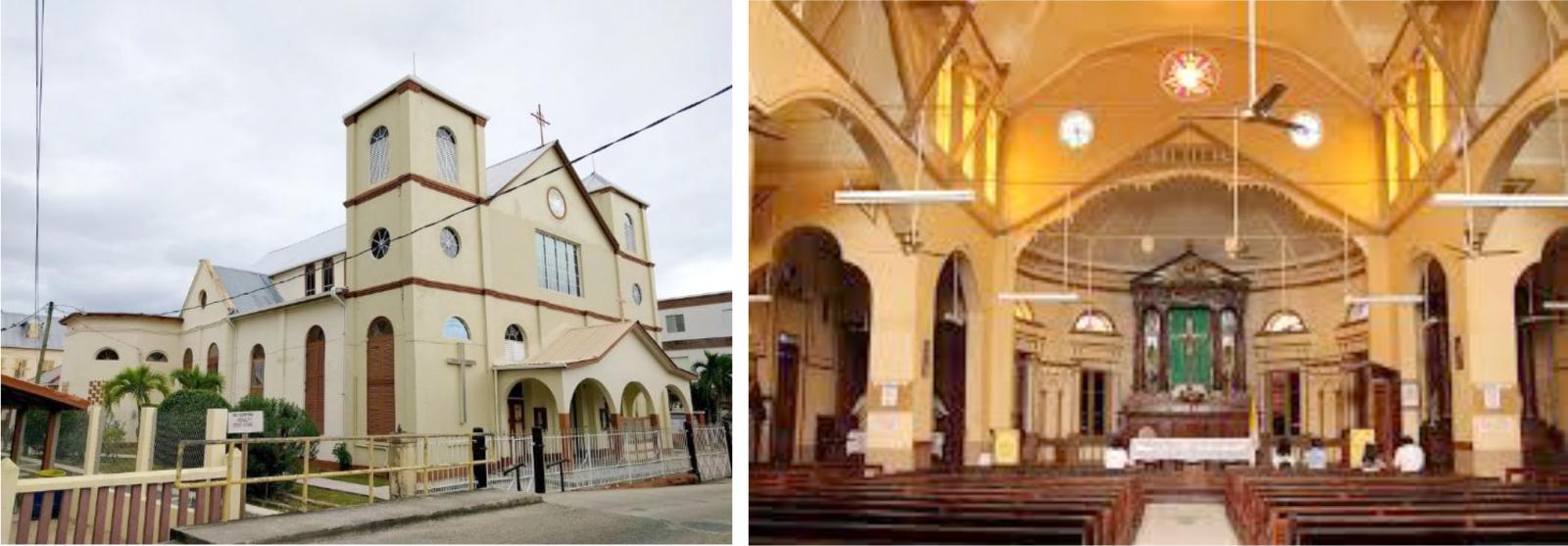 Holy Redeemer Cathedral is a Roman Catholic Cathedral in Belize City, Belize. It is canonically the Mother Church of the Roman Catholic Diocese of Belize City-Belmopan. Pope John Paul II made the first Papal visit to Belize and visited the cathedral in 1983.[1]
Holy Redeemer Cathedral is a Roman Catholic Cathedral in Belize City, Belize. It is canonically the Mother Church of the Roman Catholic Diocese of Belize City-Belmopan. Pope John Paul II made the first Papal visit to Belize and visited the cathedral in 1983.[1]The present structure goes back to 1858 and is of brick, mostly salvaged from the ballast of sailing ships that transported logwood and mahogany back to England. In 1888 the side walls were moved out in line with the side chapels and bell towers, with high windows and a sacristy added. The church became a cathedral in 1894, with Salvatore di Pietro the first bishop to reside in Belize. The building displayed its fully brick exterior until the 1920s, but has since been plastered over. The interior is entirely of mahogany but only the pews, high altar, and side altars retain their mahogany finish. The choir loft once housed a pipe organ, and after the 1961 hurricane the wooden floor was replaced with concrete and tile. The same storm destroyed many of the stained-glass windows and a di Pietro memorial.
Additions following Vatican II include the main altar facing the people and the tabernacle moved to a side altar, formerly Marian. The picture of Our Lady of Guadalupe now occupies the other side altar formerly dedicated to Saint Joseph. Also added in the 1970s were a baptismal font and two figured mahogany lecterns. Two of the four corner confessionals in Gothic style remain. The bishop's throne and the communion rail were removed as part of the Vatican II reforms. Two iron Corinthian pillars have been added to the front portico. Three bishops are buried under the floor of the baptismal font: di Pietro, Frederick C. Hopkins, and William A. Rice. The steeples of the twin towers have been battered over the years. The original Byzantine onion domes were changed in the early 1900s to soaring, pyramidal steeples demolished by the 1931 hurricane. Their shorter replacements were blown away in subsequent storms. The bells are in one tower; four peal for joyous events; three for funerals alternating with all four; two for church services; and one for the Angelus at 6:00 a.m., noon, and 6:00 p.m.[2]
La Inmaculada Conception (Orange Walk)
 In 1881 Orange Walk was established as a separate district from Corozal. At this time a large number of Mestizo Yucatecans were added to the primarily white and creole population. This dramatic influx of Spanish and Mestizo Catholics met with a corresponding increase in the activity of the church in Orange Walk. Although the people of the New River had been served by various priests on a missionary basis, they now welcomed their first pastor, Father Alphonse Parisi, an Italian Jesuit (sent by the church in the Yucatan). He served Orange Walk from 1875 to 1880. His church, which had been built sometime before 1872, was a simple thatched structure located near the present Pallottine Convent. Several years before his arrival, it had served the soldiers as a barracks.
In 1881 Orange Walk was established as a separate district from Corozal. At this time a large number of Mestizo Yucatecans were added to the primarily white and creole population. This dramatic influx of Spanish and Mestizo Catholics met with a corresponding increase in the activity of the church in Orange Walk. Although the people of the New River had been served by various priests on a missionary basis, they now welcomed their first pastor, Father Alphonse Parisi, an Italian Jesuit (sent by the church in the Yucatan). He served Orange Walk from 1875 to 1880. His church, which had been built sometime before 1872, was a simple thatched structure located near the present Pallottine Convent. Several years before his arrival, it had served the soldiers as a barracks. The building of the granite monument that stands in front of the present church was also directed by Father Piemonte. It was brought in pieces by boat and erected to mark the beginning of the Holy Year of the 20th century. It bears the names of the devoted citizens of Orange Walk including Mrs. P. Price, the Ayuso and Escalante families, and the Hon. J.M. Rosado. Also, there is Father Piemonte’s name.
At midnight on December 31, 1899, an outdoor Mass was celebrated by people from all over the area to mark the unveiling of the monument. There were so many people, that it took over an hour to distribute Communion. Just six months after this celebration, Father Piemonte died and was buried in Orange Walk with much ceremony and devotion. He was only 47 years old. He had begun work on the new La Inmaculada church (the present edifice) but it was up to his successor, Father Joseph Muffles, to complete his task.
Father Muffles was assigned to Orange Walk in May of 1900, and with the death of Father Piemonte in June, began his 21-year pastorship of the Orange Walk church. This was an outstanding record of service. He won the regard and affection of his people. The High School bears his name. (Shared by Nelita Castillo)
San Roman (Orange Walk)
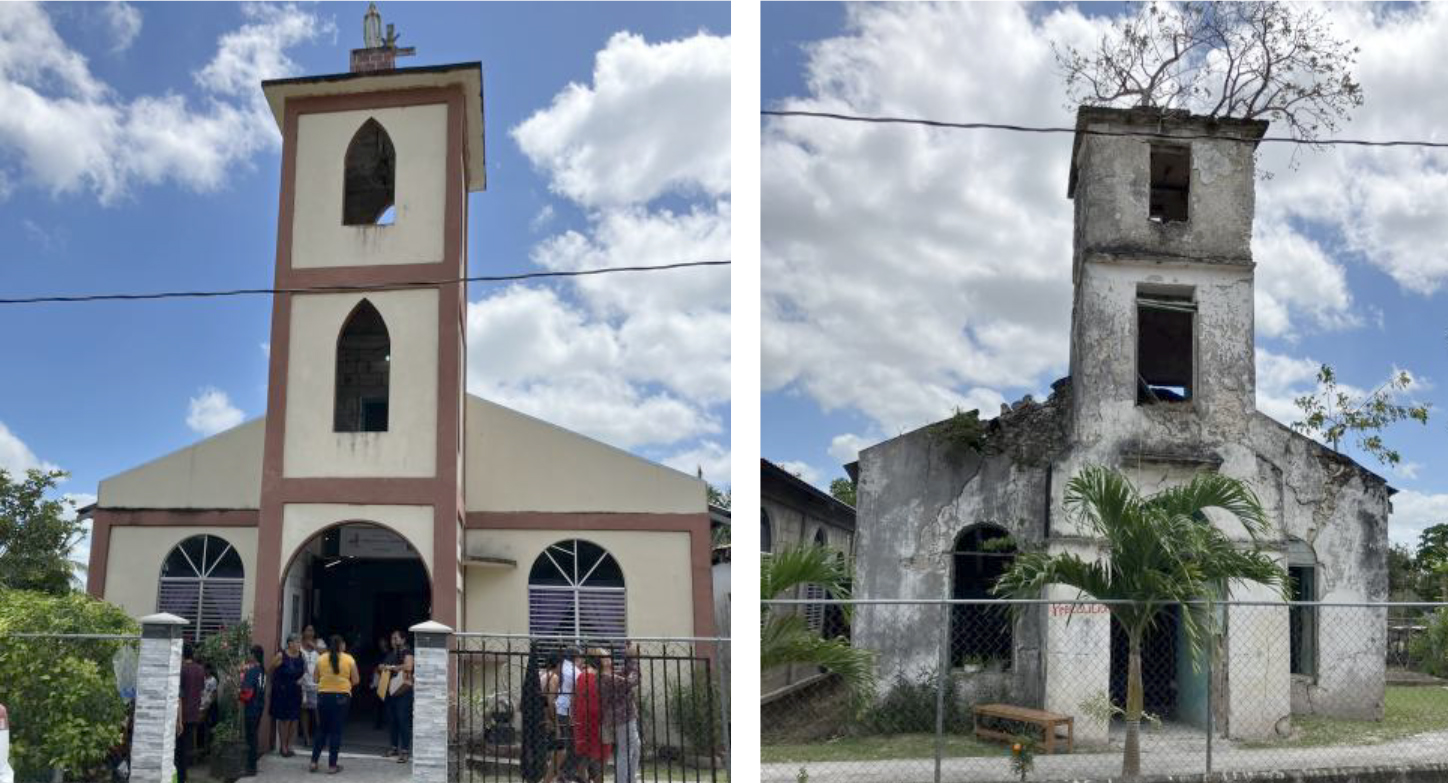 San Roman Rio Hondo Catholic Church, built in 1913, is one of Belize's oldest church!
San Roman Rio Hondo Catholic Church, built in 1913, is one of Belize's oldest church!This building upholds such a vast amount of memories, history etc. Aldeaños/ Beliceños hay que unirnos y ayudar en lo que podamos tenemos una gran hoya que no podemos abandonar.
Lucilo Sosa: It is with much nostalgia that I reminisce the mid/late forties, early/mid/late fifties, up to early sixties during my childhood days up to early teens. The construction of the early church is unknown to me but I wouldn’t be surprised if Fr. Lalin wasn’t instrumental in its genesis. Fr. Lalin arrived in Belize fleeing from prosecution from Spain’s dictator Francisco Franco. He chose to be San Roman, Río Hondo’s resident priest. The Alcoser Family took up the responsibility to be Fr. Lalin’s care taker from his arrival up to his demise. He officiated my baptismal ceremony. As a child I spent quality time conversing with him and perusing books from his library. On Sept. 27th. 1955, Janet a Cat. 5 hurricane practically wiped out San Roman partially destroying the church beyond repair. A new church was built adjacent to the previous church. Fr. Lalin was buried SW of the new church between the village well and the church. Today you can see both old and new church building side by side.
Church of San Joaquin (Corozal)
 San Joaquin Village was established in the mid-1850s by Mestizo families fleeing the Caste War 1847–1901 in Yucatan, Mexico. The village was officially named "San Joaquin" in 1904, after their patron saint, whom they believe brought them to freedom, and the church plays a central role in the community's identity. The church is the site of novenas (nine days of prayers) and a special mass during La Fiesta de San Joaquin, celebrating San Joaquin, the patron saint. The village's historical connections to Bacalar, Mexico, are reflected in the tradition of a "corrida de la antorcha" (torch marathon) that starts in Bacalar and ends in San Joaquin during the fiesta. The church serves as a vital community hub. San Joaquín is one of the largest villages in Corozal.
San Joaquin Village was established in the mid-1850s by Mestizo families fleeing the Caste War 1847–1901 in Yucatan, Mexico. The village was officially named "San Joaquin" in 1904, after their patron saint, whom they believe brought them to freedom, and the church plays a central role in the community's identity. The church is the site of novenas (nine days of prayers) and a special mass during La Fiesta de San Joaquin, celebrating San Joaquin, the patron saint. The village's historical connections to Bacalar, Mexico, are reflected in the tradition of a "corrida de la antorcha" (torch marathon) that starts in Bacalar and ends in San Joaquin during the fiesta. The church serves as a vital community hub. San Joaquín is one of the largest villages in Corozal.Saint Francis Xavier (Corozal)
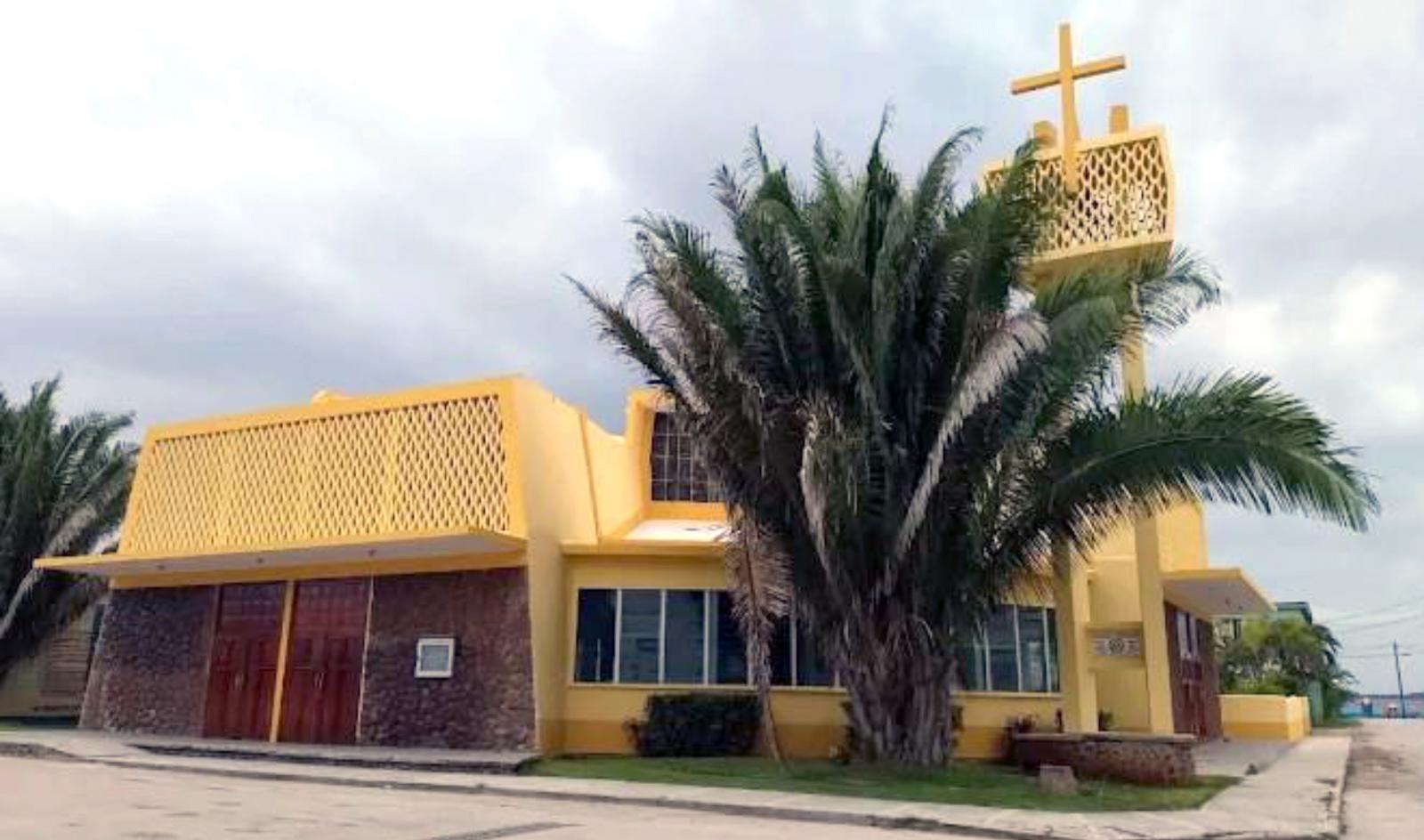 The earliest baptism known to be performed at the parish was back in November of 1848 by a visiting priest from Merida, Jose Antonio Glory, who remained here until 1859. In 1861 Fr. Ferdinando Parchi SJ open the priest residence. In 1891, the church of Corozal was consecrated, with space to hold 600 congregants. In 1900 the sisters of Mercy established a convent in Corozal. In 1913 the Pallotine sisters arrived from Germany and established a novitiate. In February of 1947, Fr. Henry Sutti SJ founded the St. Francis Xavier Credit Union. Fr, Martin Avila a diocesan priest served from 1965-1967 during which he initiated the construction of a new church with the help of the parish council, the people of the town and villages helped financially and with time and services. On May 30th 1965, the corner stone was made and Bishop Hodapp and Prime Minister George Cadle Price attended along with approximately four thousand people. In 1970 Fr. James Walsh SJ, worked with the Sisters of Mercy and the Guadalupan Sisters from Mexico the form the “Lay Ministers” who played an important role in the life of the church. In the 1980’s Fr. William Messmer SJ, brought the “Renew” program which helped to grow the faith in the community. In 1990, Fr. Lazarus Augustine and the “Madres de La Luz” organized support for the villages. On September 15th 1998, the “Clerics of St. Viator” led by Fr. Dan Hall and Fr. Chris Clancy, took responsibility for the church and its faith formation. In 2017 The Order of Friars Minor” or “Franciscans” accepted the responsibility to the church and its missions in the Corozal District.
The earliest baptism known to be performed at the parish was back in November of 1848 by a visiting priest from Merida, Jose Antonio Glory, who remained here until 1859. In 1861 Fr. Ferdinando Parchi SJ open the priest residence. In 1891, the church of Corozal was consecrated, with space to hold 600 congregants. In 1900 the sisters of Mercy established a convent in Corozal. In 1913 the Pallotine sisters arrived from Germany and established a novitiate. In February of 1947, Fr. Henry Sutti SJ founded the St. Francis Xavier Credit Union. Fr, Martin Avila a diocesan priest served from 1965-1967 during which he initiated the construction of a new church with the help of the parish council, the people of the town and villages helped financially and with time and services. On May 30th 1965, the corner stone was made and Bishop Hodapp and Prime Minister George Cadle Price attended along with approximately four thousand people. In 1970 Fr. James Walsh SJ, worked with the Sisters of Mercy and the Guadalupan Sisters from Mexico the form the “Lay Ministers” who played an important role in the life of the church. In the 1980’s Fr. William Messmer SJ, brought the “Renew” program which helped to grow the faith in the community. In 1990, Fr. Lazarus Augustine and the “Madres de La Luz” organized support for the villages. On September 15th 1998, the “Clerics of St. Viator” led by Fr. Dan Hall and Fr. Chris Clancy, took responsibility for the church and its faith formation. In 2017 The Order of Friars Minor” or “Franciscans” accepted the responsibility to the church and its missions in the Corozal District.Divine Mercy Church
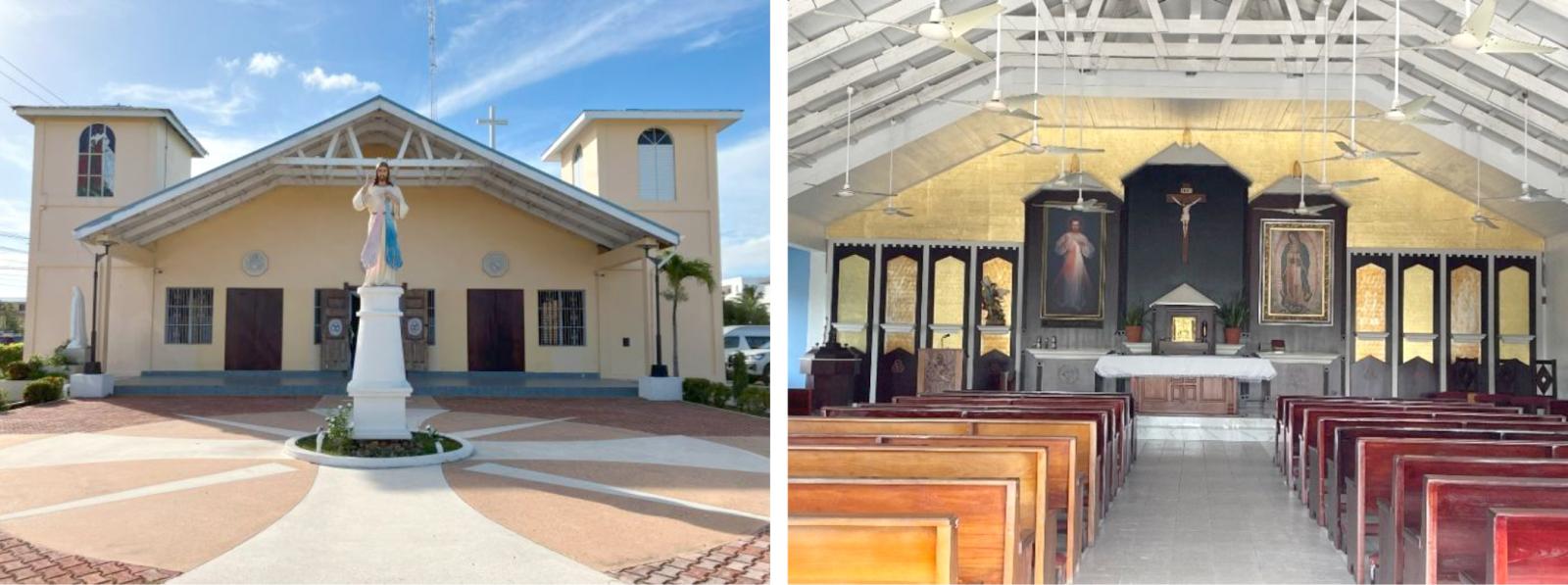 Divine Mercy Church in Belize City was founded in 1990 by the Society of Our Lady of the Most Holy Trinity (SOLT). The history of the SOLT, and therefore Divine Mercy Church, is closely tied to its mission of serving the people of Belize. SOLT's work in Belize, including the founding of Divine Mercy Church, reflects a broader history of Catholic missionaries and organizations in Belize, as detailed in the history of the Catholic Church in Belize, which includes periods of missionary activity among the Maya and the establishment of various schools and parishes. The Divine Mercy devotion itself, which the church is named after, has roots in the experiences of St. Maria Faustina Kowalska in Poland, who was chosen to communicate a message of mercy from Jesus to the world.
Divine Mercy Church in Belize City was founded in 1990 by the Society of Our Lady of the Most Holy Trinity (SOLT). The history of the SOLT, and therefore Divine Mercy Church, is closely tied to its mission of serving the people of Belize. SOLT's work in Belize, including the founding of Divine Mercy Church, reflects a broader history of Catholic missionaries and organizations in Belize, as detailed in the history of the Catholic Church in Belize, which includes periods of missionary activity among the Maya and the establishment of various schools and parishes. The Divine Mercy devotion itself, which the church is named after, has roots in the experiences of St. Maria Faustina Kowalska in Poland, who was chosen to communicate a message of mercy from Jesus to the world. 


